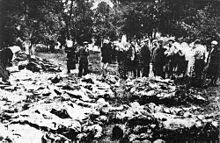
Back تقدير عدد ضحايا عهد يوسف ستالين في الاتحاد السوفيتي Arabic Exceso de mortalidad en la Unión Soviética bajo Iósif Stalin Spanish Tingkat kematian di Uni Soviet di bawah kepemimpinan Josef Stalin ID Presežna umrljivost v Sovjetski zvezi v času Josifa Stalina Slovenian Прекомерна смртност у Совјетском Савезу под Јосифом Стаљином Serbian Josef Stalin yönetimindeki Sovyetler Birliği'nde ölümler Turkish

| ||
|---|---|---|
|
Pre-leadership Leader of the Soviet Union Political ideology Works
Legacy  |
||
Estimates of the number of deaths attributable to the Soviet revolutionary and dictator Joseph Stalin vary widely.[1] The scholarly consensus affirms that archival materials declassified in 1991 contain irrefutable data far superior to sources used prior to 1991, such as statements from emigres and other informants.[2][3][4]
Before the dissolution of the Soviet Union and the archival revelations, some historians estimated that the numbers killed by Stalin's regime were 20 million or higher.[5][6][7] After the Soviet Union dissolved, evidence from the Soviet archives was declassified and researchers were allowed to study it. This contained official records of 799,455 executions (1921–1953),[8] around 1.7 million deaths in the Gulag,[9][10] some 390,000[11] deaths during the dekulakization forced resettlement, and up to 400,000 deaths of persons deported during the 1940s,[12] with a total of about 3.3 million officially recorded victims in these categories.[13] According to historian Stephen Wheatcroft, approximately 1 million of these deaths were "purposive" while the rest happened through neglect and irresponsibility.[2] The deaths of at least 5.5 to 6.5 million[14] persons in the Soviet famine of 1932–1933 are sometimes, though not always, included with the victims of the Stalin era.[2][15]
- ^ Cite error: The named reference
:4was invoked but never defined (see the help page). - ^ a b c Wheatcroft, Stephen (1996). "The Scale and Nature of German and Soviet Repression and Mass Killings, 1930–45" (PDF). Europe-Asia Studies. 48 (8): 1334, 1348. doi:10.1080/09668139608412415. JSTOR 152781.
The Stalinist regime was consequently responsible for about a million purposive killings, and through its criminal neglect and irresponsibility it was probably responsible for the premature deaths of about another two million more victims amongst the repressed population, i.e. in the camps, colonies, prisons, exile, in transit and in the POW camps for Germans. These are clearly much lower figures than those for whom Hitler's regime was responsible.
- ^ Cite error: The named reference
Wheatcroft2000was invoked but never defined (see the help page). - ^ Healey, Dan (1 June 2018). "Golfo Alexopoulos. Illness and Inhumanity in Stalin's Gulag". The American Historical Review. 123 (3): 1049–1051. doi:10.1093/ahr/123.3.1049. ISSN 0002-8762.
New studies using declassified Gulag archives have provisionally established a consensus on mortality and "inhumanity."
- ^ Robert Conquest. The Great Terror. NY Macmillan, 1968 p. 533 (20 million)
- ^ Anton Antonov-Ovseyenko, The Time of Stalin, NY Harper & Row 1981. p. 126 (30–40 million)
- ^ Elliot, Gill. Twentieth Century Book of the Dead. Penguin Press 1972. pp. 223–224 (20 million)
- ^ Seumas Milne: "The battle for history", The Guardian. (12 September 2002). Retrieved 14 July 2013.
- ^ Haynes, Michael (2003). A Century of State Murder?: Death and Policy in Twentieth Century Russia. Pluto Press. pp. 214–215. ISBN 978-0745319308.
- ^ Applebaum, Anne (2003) Gulag: A History. Doubleday. ISBN 0767900561 pp. 582–583.
- ^ Pohl, J. Otto (1997). The Stalinist Penal System. McFarland. p. 58. ISBN 0786403365.
- ^ Pohl, J. Otto (1997). The Stalinist Penal System. McFarland. p. 148. ISBN 0786403365. Pohl cites Russian archival sources for the death toll in the special settlements from 1941–49
- ^ Wheatcroft, Stephen G. (1999). "Victims of Stalinism and the Soviet Secret Police: The Comparability and Reliability of the Archival Data. Not the Last Word" (PDF). Europe-Asia Studies. 51 (2): 315–345. doi:10.1080/09668139999056.
During 1921–53, the number of sentences was (political convictions): sentences, 4,060,306; death penalties, 799,473; camps and prisons, 2,634397; exile, 413,512; other, 215,942. In addition, during 1937–52 there were 14,269,753 non-political sentences, among them 34,228 death penalties, 2,066,637 sentences for 0–1 year, 4,362,973 for 2–5 years, 1,611,293 for 6–10 years, and 286,795 for more than 10 years. Other sentences were non-custodial
- ^ R. Davies; S. Wheatcroft (2009). The Industrialisation of Soviet Russia Volume 5: The Years of Hunger: Soviet Agriculture 1931–1933. Palgrave Macmillan. p. 401. ISBN 978-0230238558.
- ^ Cite error: The named reference
Ellman2002was invoked but never defined (see the help page).
